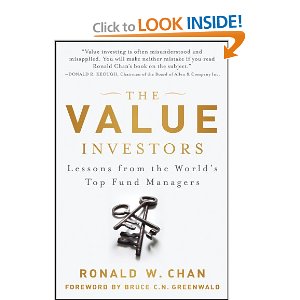An off-beat view on Education
A Video (talk at Dartmouth College) on education of millionaires: http://youtu.be/A26zIO5-Ndk Several good insights for college students, MBAs, and those seeking their calling.
Jobs at Startups: http://workingforwonka.com/
By the way, I tried to form a club for eccentrics, but failed. There is a club in Britain:http://www.eccentricclub.co.uk/
Readings on the failure of American Education: https://mises.org/(S(mrwesouecuedw155nqokwk45))/Literature/Subject/133/Education
A Book Recommendation for Beginners
Foreword to The Value Investors, Lessons from the World’s Top Fund Managers by Ronald Chan. I recommend this book for beginners who want a broad overview of investors who have the necessary mindsets and temperaments to practice value investing (buying bargains). Experienced pros may already have this knowledge within their grasp. As the author writes, “After becoming a value investor myself, I began to explore the different types of investment valuation methods for sizing up businesses and investment opportunities. At first, I thought that the perfect valuation formula was the holy grail of investment success, but I soon came to realize that this is NOT the case. Instead, it is the right investment mindset, or temperament, that distinguishes the fair-to-good investor from the good-to-great one. …..Value investing is not a staid and old-fashioned investment strategy, but is dynamic and ever-evolving.
Prof Greenwald’s Foreword
Students of investing look for a formula, a way of combining accounting and other information that will produce infallibly good investment results. Even Benjamin Graham, the founder and leading spirit of by far the most successful school of investment practice, spent a good deal of his time looking for such a formula. To this end, students read both technical works and the retrospective testimonies of high performing investors. In both areas, they are largely disappointed.
The technical approaches have a meager record of success. A few notable good books have been written (for example Joel Greenblatt’s You Can be a Stock Market Genius and Graham and Dodd’s Security Analysis). But reported technical investment approaches rarely, if ever, lead to consistent, high-level returns (if they did they would be adopted by everyone and would become self-defeating).
—
A contrasting view FOR quantitative value investing:Greenbackd-Case-for-Quantitative-Value-Eyquem-Global-Strategy
—
Investment memoirs generally also disappoint students. They tend to be long on philosophy and short on advice for HOW to buy particular securities. However, as the works of successful investment practitioners, the memoirs do have much to recommend them. They describe, however non-specifically, investment approaches that worked in practice. And they capture an important aspect of investment success: that it depends more on character than on mathematical or technical ability. This is the consistent message of investment memoirs as a group.
The problem is that each memoir presents a unique perspective on the character traits necessary for investment success. Different authors emphasize different characteristics: patience, coolness in a crisis, wide-ranging curiosity, diligence in pursuit of information, independent thought, broad qualitative as opposed to detailed quantitative understanding, humility, a proper appreciation of risk and uncertainty, a long time horizon, intellectual vigor and balance in analysis, a willingness to live outside the herd, and the ability to maintain a consistently critical perspective. Unfortunately, an investor with all these qualities is a rare bird indeed.
That is why Ronald Chan has done such a valuable service in writing this book. He has put together a set of thorough and rigorous portraits of a comprehensive range of notable value investors in a manageably short number of pages. His descriptions cover multiple generations from Walter Schloss and Irving Kahn to William Browne, multiple geographies from Asia to the United States to Europe and the full gamut of value investing styles. By combining descriptions of investment approaches with investor background, he illuminates the connection between individual character and effective investment practice. Taken as a whole, the book provides each practical value investor with the necessary material to sift through the historical records to find the style that is most appropriate to them.
Ronald Chan’s work is an essential starting point for any nascent value investor and an invaluable reference for experienced investors.
From the Author
Q&A on The Value Investors: Lessons from the World’s Top Fund Managers
with author Ronald W. Chan
Why did you decide to write The Value Investors: Lessons from the World’s Top Fund Managers?
As a value fund manager myself, I have never felt that an investment skill set alone is the determining factor in beating the stock market. Rather, it has more to do with one’s temperament and investment philosophy. To learn more about these qualities, I tried to look into the life and career experiences of successful value investors around the world, but was able to find only information on their investment performance or current outlook.
The idea of writing this book emerged with the realization that to truly understand the essence of value investing, I needed to learn more about the career paths and life encounters of its successful practitioners. In 2011 and 2012, I interviewed 12 renowned value investors from different parts of the world. They told me about their personal background and shared their life stories, and in the book I inform readers of why and how they became value investors in the first place and what has made them successful.
Who should read this book?
I believe anyone who is interested in investing and in sensible money management should read this book. As Professor Bruce Greenwald, Director of the Heilbrunn Center for Graham and Dodd Investing at Columbia University, put it, the book is a good “starting point for any nascent value investor and an invaluable reference for experienced investors.”
It is important to note that the book is not an in-depth analysis of investment theories or formulas. Instead, it tells the life stories of tried and true value investors, who inform us of how they started out and how they became who they are today.
What is the one thing that all of the value investors you interviewed have in common?
They are all curious about the world. They are curious about human psychology, about how businesses function, and about how the world is progressing. In effect, this means that they never stop reading and learning because they always want to know more. By that, I don’t mean that they read romance novels or gossip magazines, but rather useful materials and information that will improve their knowledge and give them an edge when it comes to investment decision making.
People often ask these investors how they generate ideas, and their answer is simply “I read a lot.” Although this answer may not seem helpful on the face of it, idea generation involves more than waking up one day and deciding to look for inspiration. It is important to have a disciplined reading and learning routine, to try to understand the world in a systematic manner, and to synthesize all of the information you have accumulated. Then, inspiration may strike.
From the Inside Flap
Investing legend Warren Buffett once said that “success in investing doesn’t correlate with I.Q. once you’re above the level of 125. Once you have ordinary intelligence, what you need is the temperament to control the urges that get other people into trouble in investing.”
In an attempt to understand exactly what kind of temperament Buffett was talking about, author Ronald Chan interviewed twelve value-investing legends from around the world, learning how their personal background, culture, and life experiences have shaped their investment mindset and strategy. The Value Investors: Lessons from the World’s Top Fund Managers is the result.
From 106-year-old Irving Kahn, who worked closely with the “father of value investing” Benjamin Graham and remains active today; and 95-year-old Walter Schloss, described by Warren Buffett as the “super-investor from Graham-and-Doddsville;” to Cheah Cheng Hye and V-Nee Yeh, the cofounders of Hong Kong-based Value Partners; and Francisco García Paramés of Spain’s Bestinver Asset Management; author Ronald Chan chose investment luminaries to help him understand the international appeal—and success—of value investing. All of these individuals became strong advocates of the approach despite considerable age and cultural differences. Here, Chan finds out why.
From a reader:
In The Value Investors, readers will also discover how these investors, each of whom has a unique value perspective, have consistently beaten the stock market over the years. Do they share a trait that allows this to happen? Is there a winning temperament that turns the ordinary investor into an extraordinary one? This book answers these questions and much more.
Irving Kahn, age 106, has the distinction of being the oldest living active investment professional. Both he and Walter Schloss, who died this year at the age of 95, were students and later employees of Benjamin Graham, so they have impressive value investing pedigrees. Their first jobs were with Wall Street firms; eventually they founded their own highly successful businesses.
I mention the job history of these two men because I was struck by how relatively late in life (of course, not by Kahn standards) many of the value fund managers interviewed in this book found their true calling. Mark Mobius, for instance, of the Templeton Emerging Markets Group fame, started his career as a business consultant (to be more precise, a consulting research coordinator) in Tokyo, studying consumer behavior in the region, and later founded his own research-oriented business consulting firm. Cheah Cheng Hye, co-founder of Value Partners, the largest asset management company in Asia, worked in journalism for eighteen years before he entered the financial world as a stock analyst.
Other future value fund managers started off in finance but faced a different kind of hurdle. They were hired by firms who were devoted to growth investing. They felt uncomfortable in their jobs, though not necessarily understanding why. It took them some time to realize that they were, for whatever psychological/intellectual reasons, at heart and in mind value investors.
Value investing is in many ways an intellectual no-brainer. It’s smart bargain shopping. You buy a lot of pasta at 50% off because the supermarket messed up its inventory but avoid the strawberries that are on sale because they’re half rotten. Simple enough. On the other hand, value investing is extraordinarily difficult emotionally. You buy a stock that you think is undervalued only to see it become even more undervalued (and that’s if your analysis is correct). You may buy more if you’re self-confident, but you have no external validation. The market is telling you that you got it wrong. And, yes, the market is often right.
The value investors that Chan profiles, all of whom have handily beat their benchmarks, are not a particularly stressed lot. In fact, many of them explain what investing techniques they use (in some cases merely diversification) to be able to sleep soundly at night and avoid stress. I suspect, however, that the real explanation lies not so much in methodology as in personality. It takes a special kind of person to take the inevitable lumps (such as not participating in the dot-com boom) as well as to enjoy the long-term, often slow-grind upside of being a talented value investor.
Chan’s book is a good read. Value investors may make some new international friends. Struggling individual investors may find a style that resonates. And frustrated, antsy twenty-somethings may come to realize that life doesn’t end at thirty.













